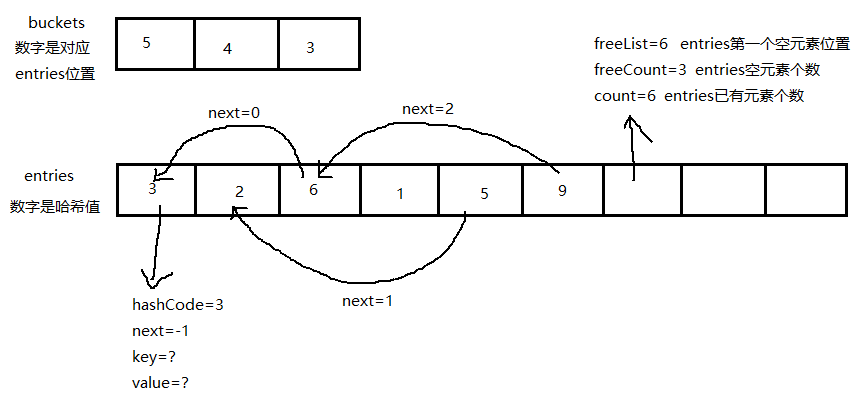通过查阅网上相关资料和查看微软源码,我对Dictionary有了更深的理解。
Dictionary,翻译为中文是字典,通过查看源码发现,它真的内部结构真的和平时用的字典思想一样。
我们平时用的字典主要包括两个两个部分,目录和正文,目录用来进行第一次的粗略查找,正文进行第二次精确查找。通过将数据进行分组,形成目录,正文则是分组后的结果。
而Dictionary对应的是 int[] buckets 和 Entry[] entries,buckets用来记录要查询元素分组的起始位置(这么些是为了方便理解,其实是最后一个插入元素的位置没有元素为-1,查找同组元素通过 entries 元素中的 Next 遍历,后面会提到),entries记录所有元素。分组依据是计算元素 Key 的哈希值与 buckets 的长度取余,余数就是分组,指向buckets 位置。通过先查找 buckets 确定元素分组的起始位置,再遍历分组内元素查找到准确位置。与对应的目录和正文相同,buckets的 长度小于等于 entries,buckets 的长度使用 HashHelpers.GetPrime(capacity) 计算,是一个计算得到的最优值。capacity是字典的容量,大于等于字典中实际存储元素个数。
Dictionary与真实的字典不同之处在于,真实字典的分组结果的物理位置是连续的,而 Dictionary 不是,他的物理位置顺序就是插入的顺序,而分组信息记录在 entries 元素中的 Next 中,Next 是个 int 字段,用来记录同组元素的下一个位置(若当前为该组第一个插入元素则记录-1,第一个插入元素在分组遍历的最后一个)
解析一下Dictionary的几个关键方法
1.Add(Insert 新增&更新方法)
Add和使用[]更新实际就是调用的Insert,代码如下。
首先计算key的哈希值,与buckets取余后确定目录位置,找到entries的位置,
public void Add(TKey key, TValue value) { Insert(key, value, true); }
public TValue this[TKey key] { get { int i = FindEntry(key); if (i >= 0) return entries[i].value; ThrowHelper.ThrowKeyNotFoundException(); return default(TValue); } set { Insert(key, value, false); } }
private void Insert(TKey key, TValue value, bool add) { if (key == null) { ThrowHelper.ThrowArgumentNullException(ExceptionArgument.key); } if (buckets == null) Initialize(0); int hashCode = comparer.GetHashCode(key) & 0x7FFFFFFF; int targetBucket = hashCode % buckets.Length; #if FEATURE_RANDOMIZED_STRING_HASHING int collisionCount = 0; #endif for (int i = buckets[targetBucket]; i >= 0; i = entries[i].next) { if (entries[i].hashCode == hashCode && comparer.Equals(entries[i].key, key)) { if (add) { ThrowHelper.ThrowArgumentException(ExceptionResource.Argument_AddingDuplicate); } entries[i].value = value; version++; return; } #if FEATURE_RANDOMIZED_STRING_HASHING collisionCount++; #endif } int index; if (freeCount > 0) { index = freeList; freeList = entries[index].next; freeCount--; } else { if (count == entries.Length) { Resize(); targetBucket = hashCode % buckets.Length; } index = count; count++; } entries[index].hashCode = hashCode; entries[index].next = buckets[targetBucket]; entries[index].key = key; entries[index].value = value; buckets[targetBucket] = index; version++; #if FEATURE_RANDOMIZED_STRING_HASHING #if FEATURE_CORECLR // In case we hit the collision threshold we'll need to switch to the comparer which is using randomized string hashing // in this case will be EqualityComparer<string>.Default. // Note, randomized string hashing is turned on by default on coreclr so EqualityComparer<string>.Default will // be using randomized string hashing if (collisionCount > HashHelpers.HashCollisionThreshold && comparer == NonRandomizedStringEqualityComparer.Default) { comparer = (IEqualityComparer<TKey>) EqualityComparer<string>.Default; Resize(entries.Length, true); } #else if(collisionCount > HashHelpers.HashCollisionThreshold && HashHelpers.IsWellKnownEqualityComparer(comparer)) { comparer = (IEqualityComparer<TKey>) HashHelpers.GetRandomizedEqualityComparer(comparer); Resize(entries.Length, true); } #endif // FEATURE_CORECLR #endif }
private int FindEntry(TKey key) { if( key == null) { ThrowHelper.ThrowArgumentNullException(ExceptionArgument.key); } if (buckets != null) { int hashCode = comparer.GetHashCode(key) & 0x7FFFFFFF; for (int i = buckets[hashCode % buckets.Length]; i >= 0; i = entries[i].next) { if (entries[i].hashCode == hashCode && comparer.Equals(entries[i].key, key)) return i; } } return -1; }
2.Resize(重新调整大小)
虽然这是个私有方法,但我认为关键。它会在元素个数即将超过容量时调用,代码如下,简单说明一下。
该方法会声明一个 newBuckets 和 newEntrues 用来替换之前的 buckets 和 entrues,声明后会重构这两个数组,将 entrues 的值复制到 entrues,重新计算 newBuckets 的值,如果频繁触发该方法消耗是较大的,所以创建 Dictionary 时建议指定合理的 capacity(容量)
private void Resize(int newSize, bool forceNewHashCodes) { Contract.Assert(newSize >= entries.Length); int[] newBuckets = new int[newSize]; for (int i = 0; i < newBuckets.Length; i++) newBuckets[i] = -1; Entry[] newEntries = new Entry[newSize]; Array.Copy(entries, 0, newEntries, 0, count); if (forceNewHashCodes) { for (int i = 0; i < count; i++) { if (newEntries[i].hashCode != -1) { newEntries[i].hashCode = (comparer.GetHashCode(newEntries[i].key) & 0x7FFFFFFF); } } } for (int i = 0; i < count; i++) { if (newEntries[i].hashCode >= 0) { int bucket = newEntries[i].hashCode % newSize; newEntries[i].next = newBuckets[bucket]; newBuckets[bucket] = i; } } buckets = newBuckets; entries = newEntries; }
展示一个 Dictionary 实际存储效果图
